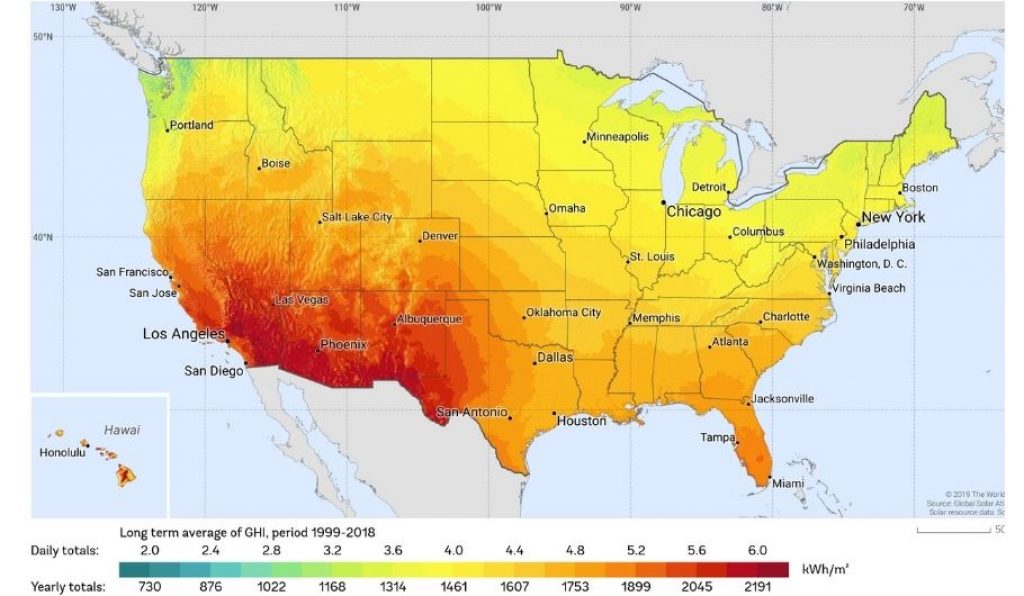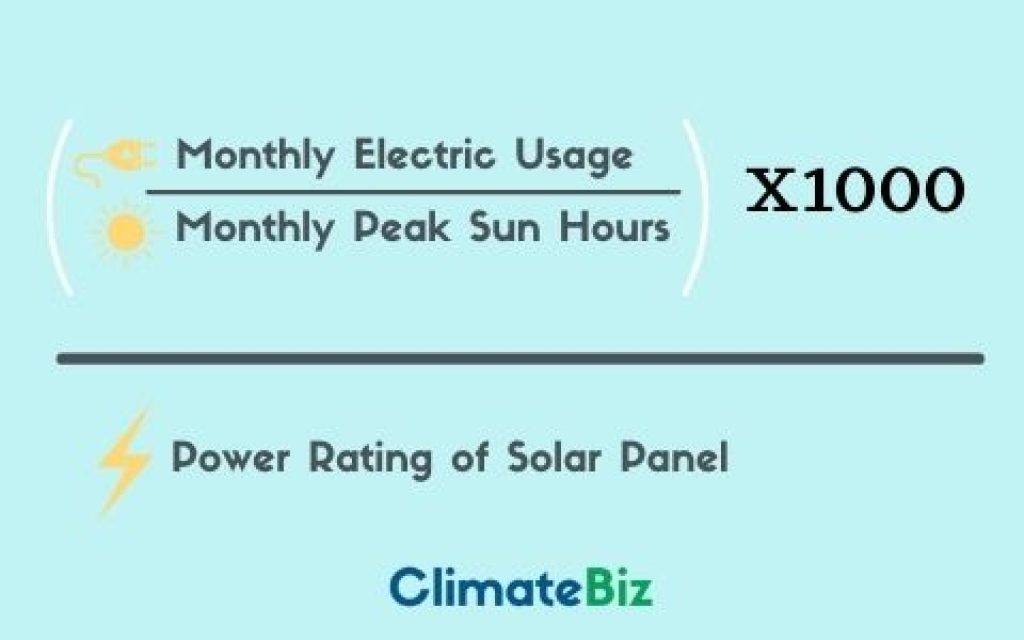If you live in California, you may wonder whether solar panels are worth the investment. And for a good reason — data from World Population Review indicates that The Golden State is the 5th sunniest state in the U.S.
Residential solar panel installation is reaching an all-time high. In fact, renewable energy installations broke new records in 2021, reaching almost 295GW, 6% higher than the all-time high of 2020.
Solar energy continues to be the favorite renewable energy among homeowners, mainly for its ease and installation cost.
This raises the question — are solar panels worth it in California?
The Global Horizontal Irradiation (GHI) average for California is 5.2kWh/m2, making it one of the prime locations within the United States for residential solar panel installation. If you live in California, we recommend investing in solar energy.
You can find your GHI here if you live in a different state within the USA.
Table of Contents
Are solar panels worth it in California?

California is blessed with increSolar panels are absolutely worth it in California ifble amounts of sun. On average, the state has approximately 284 days of sun annually.
Solar panels are worth it in California, especially if your home’s roof has sufficient space and is not suffer from too much shade.
But to truly establish whether solar panel installation is a worthwhile investment here, let’s look at the overall climate in California.
Understanding the climate in California
Like Texas, California’s climate varies greatly, ranging from scorching hot desert to alpine tundra.
Most homes near the coastline, Sierra Nevada foothills, and Central Valley will experience a Mediterranean climate. This means warmer, drier weather in summer and cooler, wetter weather in winter.
The ocean greatly influences temperature extremes, allowing for warmer winters and much cooler summers along coastal areas.
The cooling effect of the ocean has a very positive impact on solar production. This is because solar panels operating in scorching conditions are less efficient.
Generally speaking, the best months for solar production in California range from May-October. You can expect clear skies and hot temperatures to occur frequently during this time of the year.
How many peak sun hours does California receive?
Why is it important to know how many peak sunlight hours California receives?
For starters, this critical information determines how many solar panels your home will need and if it’s a worthy investment.
If you live in an area with low levels of horizontal solar irradiance (peak sun hours) and consume a lot of electricity, you’ll be better off without a solar array.
For this reason, figuring out your area’s peak daily sun hours is the first step in determining whether solar panels will be an intelligent investment.
The State of California receives approximately 5.2 kWh/m2. That’s a substantial amount of sunlight.
If you’d like to see your exact peak sunlight hours, we recommend consulting the following map:

How much would a solar system cost in California?
The cost of your solar system depends on the following:
- The amount of electricity you use per month.
- The amount of peak sunlight hours your home receives.
- The type of solar panels you choose.
- The solar brand you choose.
How much electricity do you use?
First, you need to establish your monthly electricity consumption. To do this, look at your annual electricity bill and divide the kWh usage by 31 to get your monthly consumption.
For those of you struggling to do this, the average monthly consumption in California, according to the U.S. Energy Information Administration (EIA), is 542kWh.
How many peak sunlight hours do you receive?
We’ve already established that California receives approximately 5.2 peak sun hours daily.
What type of solar panels do you want?
Monocrystalline solar panels are by far the better, more efficient choice. They’re also growing in popularity worldwide. That said, they come with a high price tag.
Your other option would be to invest in polycrystalline solar panels. These panels are less efficient but more affordable.
Which solar brand should you choose?
The solar brand you choose will impact the overall cost of your solar panel system.
Below is a table that breaks down the cost per watt for solar manufacturers in the U.S.
Bear in mind you may not need such an extensive solar system. All you may need is a 2.5kW solar system to offset your energy consumption.
That said, we’ll help you determine your home’s solar panel requirements later on.
| MANUFACTURER | COST PER WATT | PRICE RANGE (6KW SYSTEM) | PRICE RANGE (10KW SYSTEM) |
|---|---|---|---|
| Axitec | $2.17 - $2.83 | $13,020 - $16,980 | $21,700 - $28,300 |
| Aptos | $2.46 - $3 | $14,760 - $18,000 | $24,600 - $30,000 |
| Canadian Solar | $2.70 - $3.2 | $16,200 - $19,200 | $27,000 - $32,000 |
| CertainTeed Solar | $2.33 - $3.49 | $13,980 - $20,940 | $23,300 - $34,900 |
| First Solar | $2.49 - $2.57 | $14,940 - $15,420 | $24,900 - $25,700 |
| Hanwha SolarOne | $2.8 | $16,800 - $16,800 | $28,000 - $28,000 |
| Heliene | $1.88 - $2.82 | $11,280 - $16,920 | $18,800 - $28,200 |
| Hyundai | $2.39 - $3.59 | $14,340 - $21,540 | $23,900 - $35,900 |
| JA Solar | $2.32 - $3.47 | $13,920 - $20,820 | $23,200 - $34,700 |
| Jinko Solar | $2.45 - $3.09 | $14,700 - $18,540 | $24,500 - $30,900 |
| LG Solar | $2.46 - $3.38 | $14,760 - $20,280 | $24,600 - $33,800 |
| LONGi Solar | $2.24 - $3.37 | $13,440 - $20,220 | $22,400 - $33,700 |
| Mission Solar | $2.25 - $3.37 | $13,500 - $20,220 | $22,500 - $33,700 |
| Next Energy Alliance | $2.30 - $2.58 | $13,800 - $15,480 | $23,000 - $25,800 |
| Panasonic | $2.44 - $3.1 | $14,640 - $18,600 | $24,400 - $31,000 |
| Peimar Group | $2.64 - $3.96 | $15,840 - $23,760 | $26,400 - $39,600 |
| Phono Solar Technology | $2.11 - $3.16 | $12,660 - $18,960 | $21,100 - $31,600 |
| Q CELLS | $2.32 - $3.16 | $13,920 - $18,960 | $23,200 - $31,600 |
| REC | $2.32 - $3.1 | $13,920 - $18,600 | $23,600 - $31,000 |
| Risen | $2.30 | $13,800 - $13,800 | $23,000 - $23,000 |
| S-Energy | $2.07 - $3.11 | $12,420 - $18,660 | $20,700 - $31,100 |
| Seraphim | $2.03 - $3.04 | $12,180 - $18,240 | $20,300 - $30,400 |
| Silfab Solar | $2.45 - $3.09 | $14,700 - $18,540 | $24,500 - $30,900 |
| Solaria | $2.17 - $3.25 | $13,020 - $19,500 | $21,700 - $32,500 |
| SunPower | $3.12 - $3.74 | $18,720 - $22,440 | $31,200 - $37,400 |
| Suntech | $2.14 - $2.92 | $12,840 - $17,520 | $21,400 - $29,200 |
| Tesla | $2.01 - $2.04 | $12,060 - $12,240 | $20,100 - $20,400 |
| Trina Solar | $2.31 - $3.39 | $13,860 - $20,340 | $23,100 - $33,900 |
| VSUN | $2.07 - $3.11 | $12,420 - $18,660 | $20,700 - $31,100 |
| ZNShine Solar | $2.68 - $4.02 | $16,080 - $24,120 | $26,800 - $40,200 |
How many solar panels do I need for my home in California?
To calculate how much solar panels will cost for your home in California, you’ll need our solar system sizing formula.
You already have all the information stated in the 4 points above. Now you have to put it all together.
You’ll need to use the following formula to determine the number of solar panels your home requires:
Monthly electricity usage divided by monthly peak sun hours x 1000.
Then, you divide that answer by the power rating of your proposed solar panel (400 watts, for example).

Using the above formula, let’s walk you through the steps you’ll have to take (replace your information where applicable).
Step 1. Calculate your electricity usage
- For this example, we’ll use 542kWh per month.
Step 2. Determine monthly peak sun hours in California
- We know that is 5.2 hours a day as an average for the entire state of California; we then multiply that by 31 days to get the monthly value: 5.2 x 31 = 162.1 peak sun hours.
Step 3. Select the wattage and brand of your solar panels
- Most homes in California install 400-watt solar panels. Let’s use Canadian Solar as a brand for this example.
Step 4. Apply the formula above
542kWh divided by 162.1 sun hours = 3.34
3.34 x 1000 = 3340 watts
3340 watts divided by 400 watts = 8.35
9 Solar panels will need to be installed on your home in California.
If we buy our panels from Canadian Solar at $3 per watt, the total cost of our 3600-watt solar system will amount to $10,800.
As you can see, the cost of your solar system largely depends on your electricity consumption and sun hours.
If you live in a place with fewer sun hours than in California but use the same amount of electricity, you’d need to install an even bigger solar system to offset your energy usage. This would mean a higher initial investment, as you’d need more solar panels.
How long before solar panels pay themselves off in California?
This depends on the amount of electricity you consume each month and the size of the solar system you bought.
In California, the average monthly electricity consumption is 542kWh per month. The average cost per kWh in California is 26.77 cents per kWh.
Therefore the average home in California can expect to pay approximately $145 per month for electricity.
As previously discussed, you’d need a 3.6kW (3600 watts) solar system to offset this consumption. Your total cost for a 3.6kW solar system in California would be $10,800 (before tax incentives).
The Californian government allows residential customers to claim a 30 percent tax credit for installing solar systems.
Therefore, your total solar system cost would be $7560.
$7560 divided by $145 = 52 months.
52 months divided by 12 months = 4.33 years.
It’ll take a solar panel system 4.33 years to pay itself off, assuming you use around 542kWh a month. On average solar panels last 25-30 years.
This means you’ll enjoy 25 years of free electricity and save around $43,500 within that time!
Note to our readers: the savings from your solar system are slightly underestimated. Our calculation doesn’t consider the rising cost of utility electricity over the next 25 years (around 2.5% per year).
Is the investment worth it?
We’ve given you the ability to determine how much your own home’s solar system would cost. Whether solar panels are worth it or not is entirely up to you. Only you know what you can afford and how much solar savings would benefit your lifestyle.
In our opinion, if you live in California, investing in solar panels is one of the most intelligent decisions you can make.
Do you live in California and already own solar panels? Please share your experience with us.

